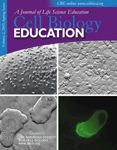Identifying Novel Helix–Loop–Helix Genes in Caenorhabditis elegans through a Classroom Demonstration of Functional Genomics
Abstract
A 14-week, undergraduate-level Genetics and Population Biology course at Morgan State University was modified to include a demonstration of functional genomics in the research laboratory. Students performed a rudimentary sequence analysis of the Caenorhabditis elegans genome and further characterized three sequences that were predicted to encode helix–loop–helix proteins. Students then used reverse transcription–polymerase chain reaction to determine which of the three genes is normally expressed in C. elegans. At the end of this laboratory activity, students were 1) to demonstrate a rudimentary knowledge of bioinformatics, including the ability to differentiate between“ having” a gene and “expressing” a gene, and 2) to understand basic approaches to functional genomics, including one specific technique for assaying for gene expression. It was also anticipated that students would increase their skills at effectively communicating their research activities through written and/or oral presentation. This article describes the laboratory activity and the assessment of the effectiveness of the activity.



